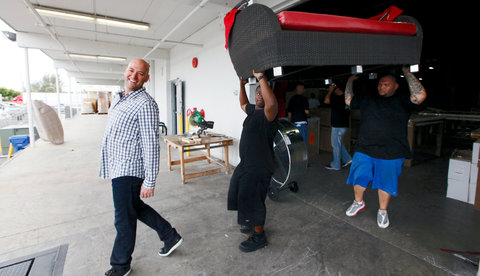Staying Alive
The struggles of a business trying to survive.
Thank you to everyone who commented on my last post, “Why I Pay What I Pay,” about the performance I expect from workers at different wage rates. I was surprised by the number of comments, but I guess that any discussion of pay is going to push someone’s button. That said, I’d like to respond to a couple of points that were raised and also make a few new ones.
First and most obvious: Every dollar I pay my workers has to come out of a client’s pocket. Having cash to make payroll is not a forgone conclusion. We scramble to make sales and bring in revenue every day. The amount of money I have on hand varies widely, but pay day arrives every two weeks like clockwork. This has caused me a lot of stress over the years and often leads me to question whether I am paying the right amount. If I were running a different kind of business — one where I knew with certainty that the money I need to meet payroll will always be there — I would think about wages differently. But I don’t have that luxury. I have to allocate our revenue stream to cover all of our operations, not just payroll, and making a mistake can be fatal. If I spend too much on the wrong thing, there will be no money for some other critical function.
Second, clients don’t care what I pay my workers. In the last three years we’ve had more than 2,000 inquiries for our product, and not a single potential buyer asked about my wage scale. These buyers also do not care whether I make a profit — as long as I deliver what they ordered. And many would probably prefer that I didn’t make any money at all, at least not on their order. As a small-business owner, I understand how important profits can be, so when I’m buying something, I don’t sweat over every penny I spend. I know that I’ll get better service and a better product from companies that aren’t struggling to make ends meet. But that perspective is unusual. Many of my clients have price targets, and they need us to hit them. They are not at all concerned with what I have to do to meet their needs.
Third, the question of how I interact with my employees is up to me. My business model and my history lead me to want to treat them well. I’m with my employees as often as I’m with my family, and I made the decision long ago that I’d rather spend my time with people who are happy to be working for me than people who hate me. It has cost me a lot of money to do this, but I believe that in the long run it has served me well.
I know a number of shop owners, running businesses like mine, who made different decisions about how to pay people. One in particular advertised his shop as a woodworking school, and charged his workers tuition. He then used their labor to build a product line that was sold at regular market prices. On the face of it, it was a brilliant business model, but he closed his doors years ago, and I’m still around. I run into his former “students” now and then, and they all describe the bitter moment when they realized what was going on and how they decided to leave as quickly as possible.
I don’t want that kind of relationship with my employees, and I don’t want to deal with constant turnover. My people are smart and hard-working and that’s who I want to spend my life with. I’d rather err on the side of paying them too much than have to deal with grumbling and turnover. But if I were running a business where turnover is expected — an ice-cream stand in a summer resort, for example — I’d have a different attitude. I’d be a lot more interested in my own reward than the long-term prosperity of my workers. And that would make sense, for that situation. On to some questions.
From kathy d:
I’d be interested in knowing how long a worker spends at each level before he/she can be promoted. Is it simply mastery of the skill set for that level, or is there a regular schedule of promotions/raises?
I’m small, so a promotion path is not a given. It’s just not possible to make that promise in a company this size. I wrote about this in the summer of 2010, and my thinking hasn’t changed.
From Meredith:
Do you offer cost of living yearly increases? Say, 2 or 3%? Or a yearly bonus for excellent performance?
Here’s my question for you, Meredith: Where’s my Cost of Progress Discount? Why am I expected to raise pay steadily when my workers’ skills set is constantly being made obsolete by market forces? Why can’t the workers who are not upgrading their own skills expect a continuous reduction of wages? This would allow their employer to compete in the market through continual, automatic cost reduction. That might sound harsh, but it reflects my reality as a manufacturer.
Seventy-five percent of what we do every day was not possible 10 years ago. I have had to re-invest cash continuously — money that could have gone into my own pocket — on new technologies, new equipment, experiments in process improvement, and employee skills development. Driven by my own desire to make my business more competitive, that effort has kept us in business. It has allowed me to keep my wages where they are. I don’t feel that workers should automatically expect pay raises unless their employer enjoys the luxury of automatic increases in revenue and profit. That’s not happening in my kind of manufacturing. As for bonuses, I have paid them in the past, based on no formula other than whether I was feeling rich and happy at the end of the year. That approach has some drawbacks, so I am implementing a regular, predictable profit-sharing plan this year. I’ll be writing more about it in the future.
From ted:
Can you tell us approximately how much the benefits you offer add to the hourly wage? (vacation, holidays, health care)
I can tell you my projections for 2013. We offer personal days, which can be used either for sickness or vacation, along with six paid holidays. New employees get six personal days in their first year of service and an additional day for each subsequent year, topping out at 16 personal days. Add the six holidays, and my long-term employees get 22 paid days off. The overall cost of doing this is tied to the pay rate and length of service for each worker, but in 2013 the total bill for paid time off will be $50,218. This includes the wages and the payroll tax we pay. That’s 5.76 percent of our total wage bill of $872,581 (excluding my pay, which is budgeted at 6 percent of sales).
As for health costs, the company pays two thirds of the cost of ensuring our those employees, and their families, who accept the coverage we offer. Twelve of my 16 workers participate, and this year the cost to the company will be $51,565. That is 5.91 percent of our total wages. The two benefits, added together, cost $101,784, or 11.66 percent of our wages. Is that expensive? Again, it depends on the context. For me, it’s not. I’d love to shed the hassle of dealing with health care, but the cost is not going to break me. And what I get for my spending on vacations and health care is a stable, healthy work force. That’s important to me, and I think it makes my shop a good place to work. Is it possible to duplicate that in every business? No.
In closing, I thought long and hard about publishing the last post, as it committed me to live up to my words and pay my people based on a clearly understood formula of skills versus pay. Many bosses wouldn’t do that, for lots of good reasons that boil down to this: published wage scales change the balance of power between bosses and employees. They make it much harder to be flexible (boss’s description) or arbitrary (employees’ description.)
In the last few years, I have made a number of changes to how I run my business, in all cases revealing information that many bosses keep secret. I am hoping that empowering my workers, letting them see what really makes the business run, will help all of us figure out how to increase sales and profits, which we can then share.
But that may not be a good idea. If it is the best way to run a business, why don’t more bosses do it? Am I compromising my own financial future for the sake of starry-eyed idealism? Would my approach work in your business?
Paul Downs founded Paul Downs Cabinetmakers in 1986. It is based outside Philadelphia.
Article source: http://boss.blogs.nytimes.com/2013/05/07/why-i-would-rather-pay-my-employees-too-much/?partner=rss&emc=rss

